If you value simplicity and speed in execution, Rytr is probably the best AI writing assistant you can choose.
Its interface is very user-friendly, and it doesn’t sacrifice too much functionality to achieve this.
Not to mention, the price is really good.
So can all of this makeup for poor long-form output, and less than ideal templates?
Let’s find out in our Rytr review.
What Is Rytr.Me
Rytr is an AI writing tool that helps you pump out content faster. Like most competitors, Rytr is based on OpenAI’s GPT-3 API, an open-source machine learning project. You just give it some instructions, and Rytr starts creating content based on them.
Is the content it writes any good?
Well, it’s complicated.

Like with most other AI writing tools, the content output can be good. If you give it valuable input, Rytr may come up with respectable blog ideas, product descriptions, or even video intros.

From our tests though, Rytr can also miss the mark quite often. Especially on longer snippets of copy. It can’t create content as effectively as other AI copywriting tools.
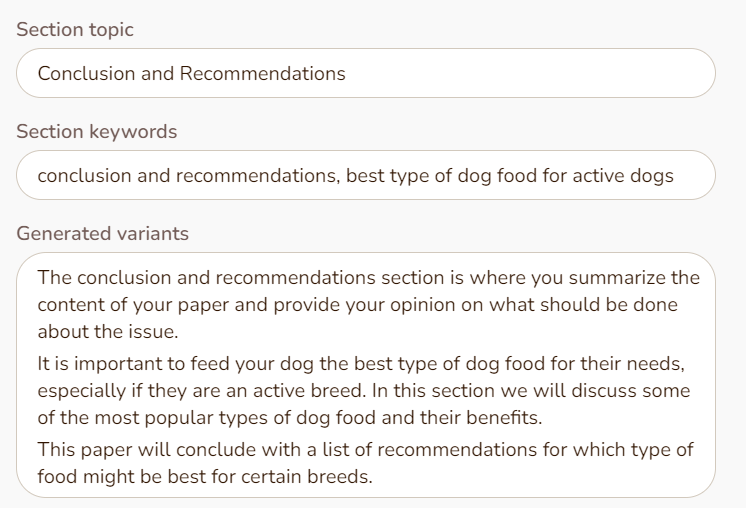
For the long answer, though, keep reading our Rytr review to learn more.
Getting Started With Rytr AI: A Quick Tour
After you sign up for Rytr, you’ll be prompted with an explainer video.
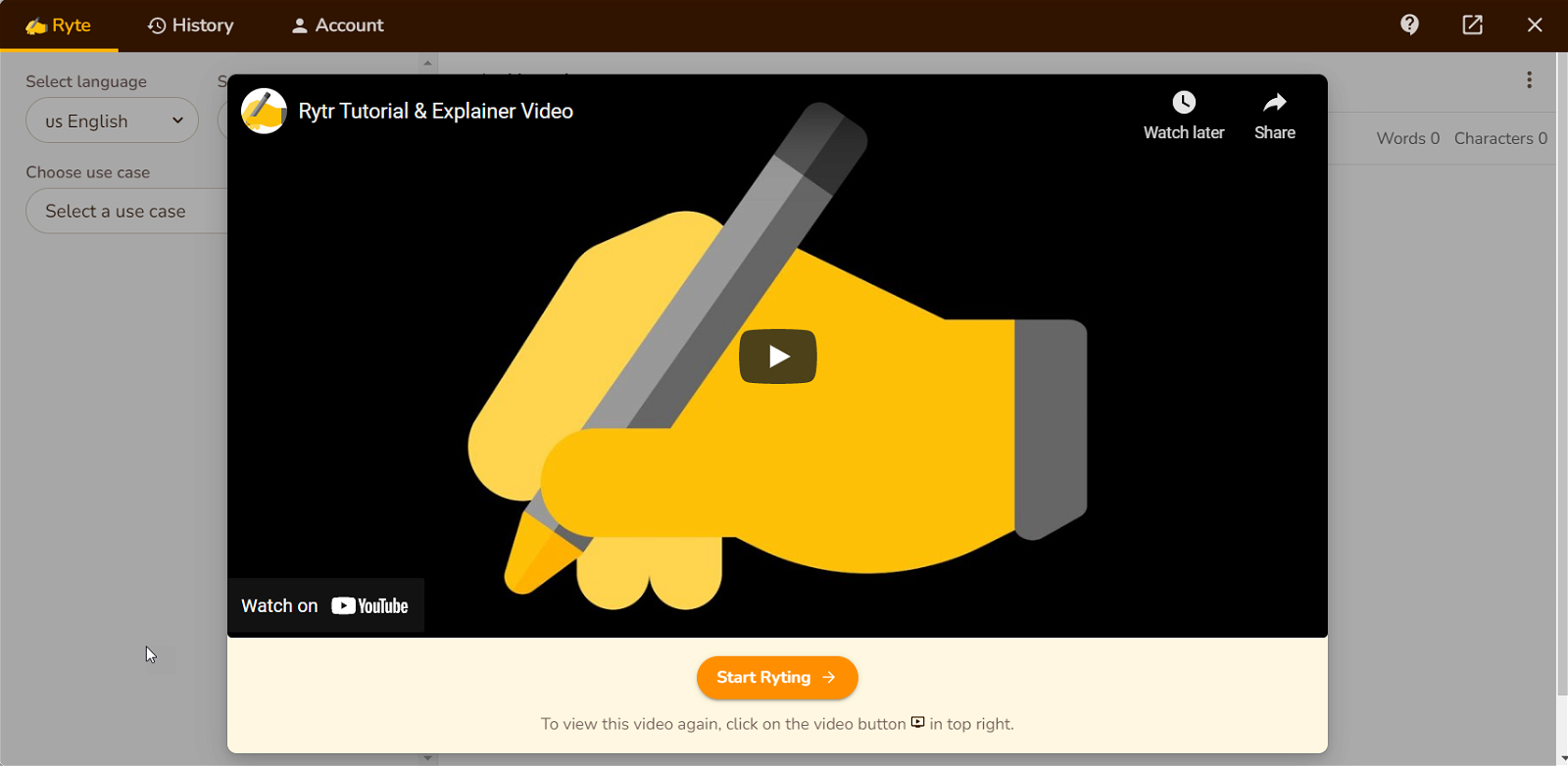
It’s pretty long, but it’s well worth your 8 minutes. It’ll help you generate content much faster.
Then, you’re thrown straight into the AI writing software.
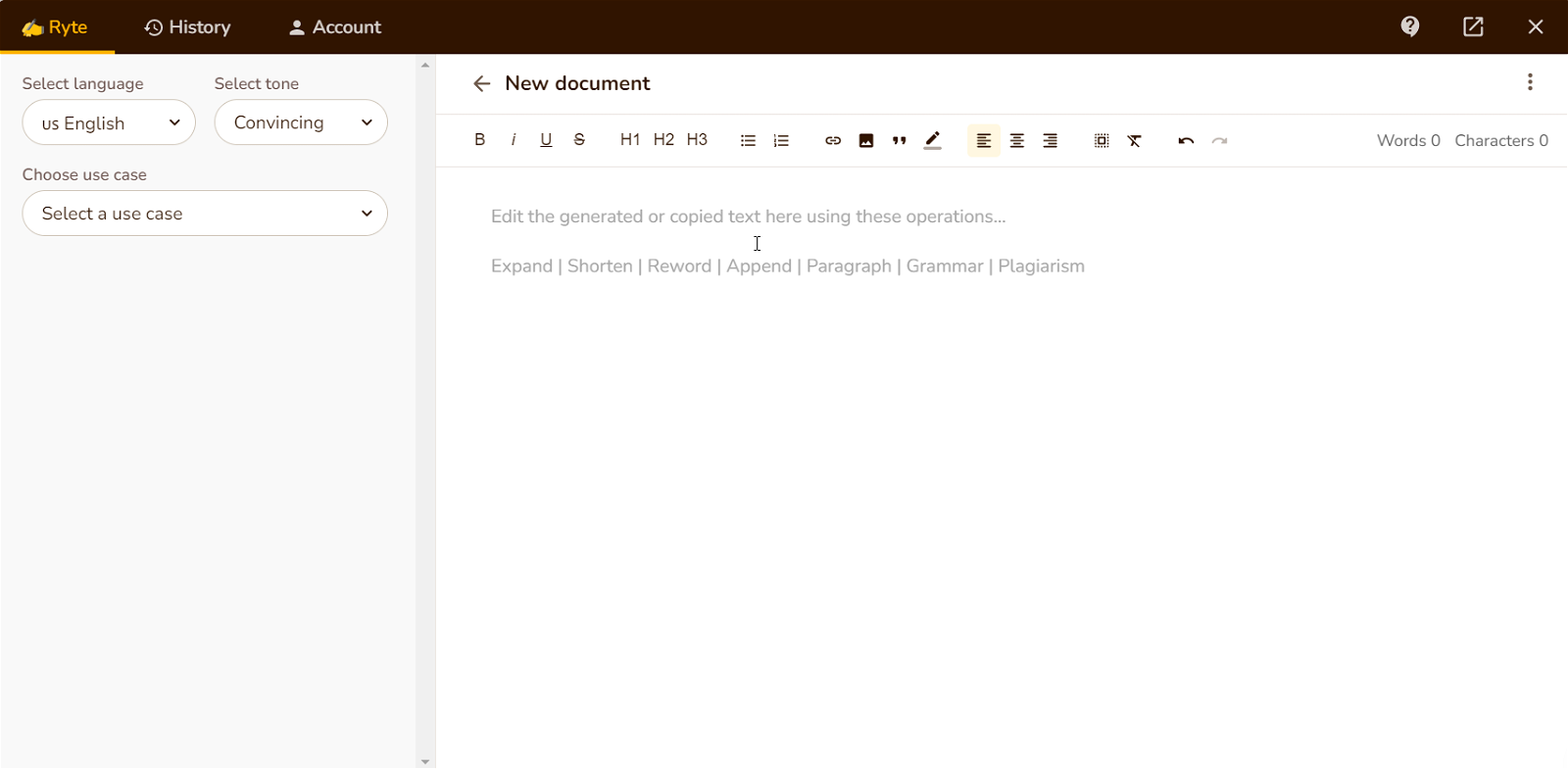
Believe it or not, this user interface is 90% of Rytr. In this compact screen, you’ll do most of your content creation and editing.
To get started, you’ll need to fill in some details on the left side of the screen.

You’ll need to pick a tone, a use case, and a language for Rytr to generate content in.
Rytr can generate content in 29 languages. That’s the most out of all AI writing software, so it’s definitely a plus if you need to generate content in multiple languages.
After you decide on the tone, language, and use case, more options will pop up:
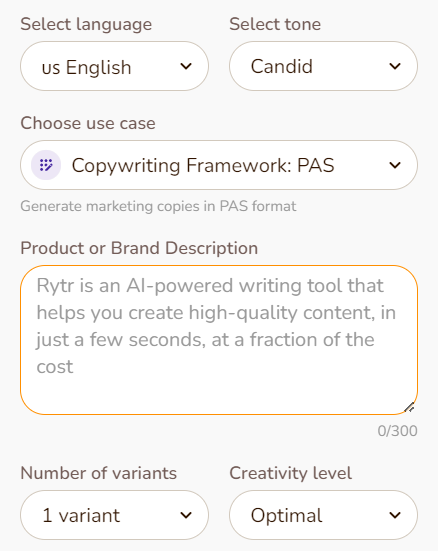
Each use case has a different input field.
For social media posts, you’ll just have to describe your post. For creative content, you might need to give Rytr a bit more information to help it write high-quality content.
Besides that, you also have to decide how many variants you want.
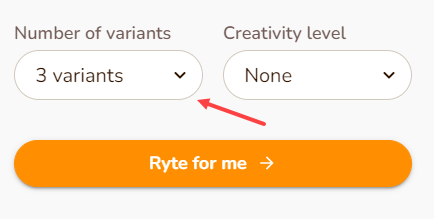
You can choose 1, 2, or 3 variants, and this just dictates how many versions of the output you’ll get.
The average AI writing assistant will provide 3 versions of any text by default. But it’s great that you have this choice since the cheaper Rytr plans have strict word count limits.
Lastly, you can also choose the creativity level of Rytr’s content creation:
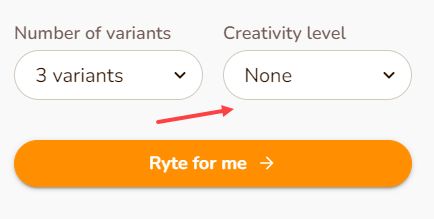
But I’m honestly not sure what this does.
I tried to generate content with different creativity levels, and there was no difference. So either I’m missing something, or you can disregard this option.
After you get your content generated, you get a ton of tools to edit it on the fly:

We’ll talk more about each of them in the Features section of this review. For now, just know these are really helpful. You can use them to rephrase stuff, correct Rytr’s grammar, and even check for plagiarism.
Lastly, you can see the complete history of your content writing, and also change the settings of your account:
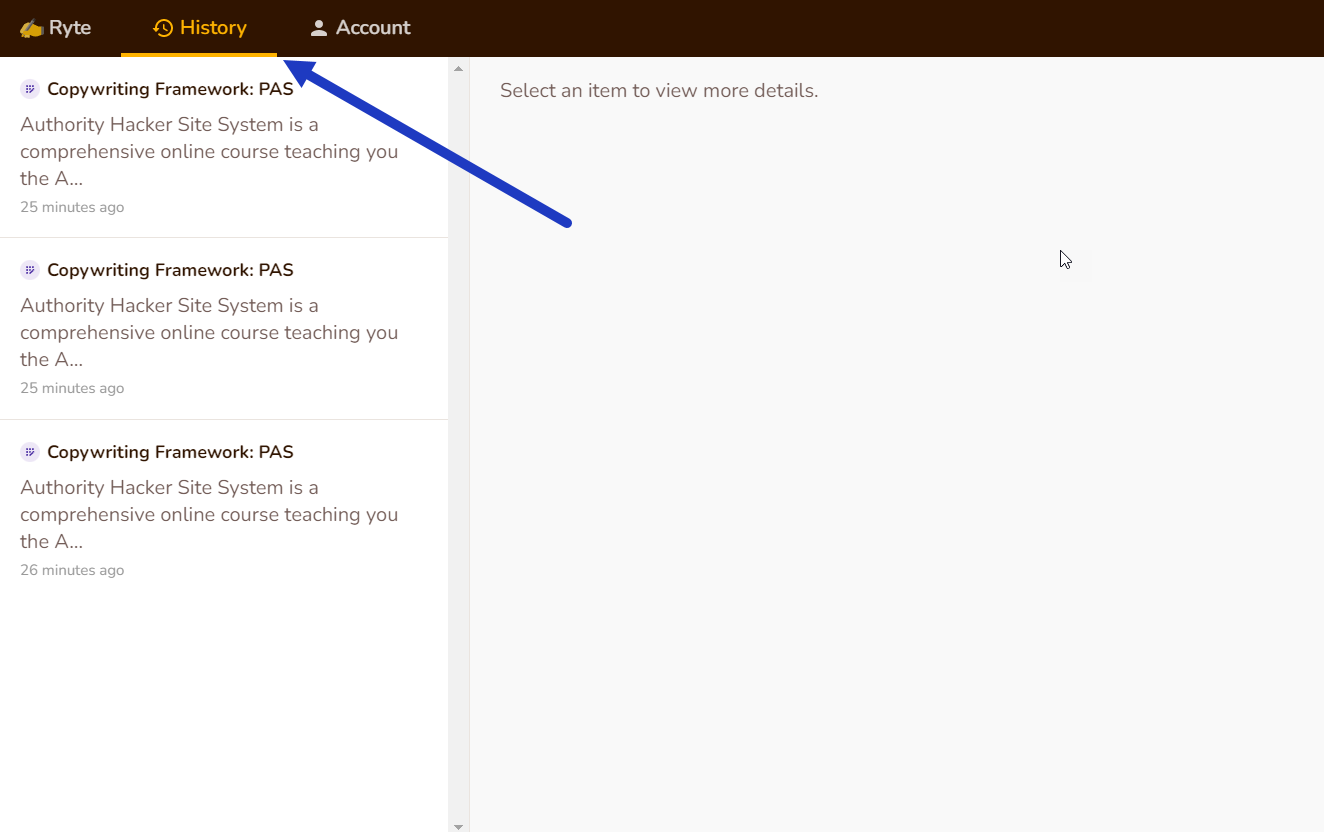
And that’s about it for our quick tour!
But we still didn’t get to highlight everything this AI writing tool can do.
So if you want the full scoop, keep reading our Rytr review.
Rytr Features And Use Cases
Rytr’s interface and ease of use are its biggest perks. Everything you can do with it, from long-form content creation to whipping up social media posts, is concentrated in this one screen:
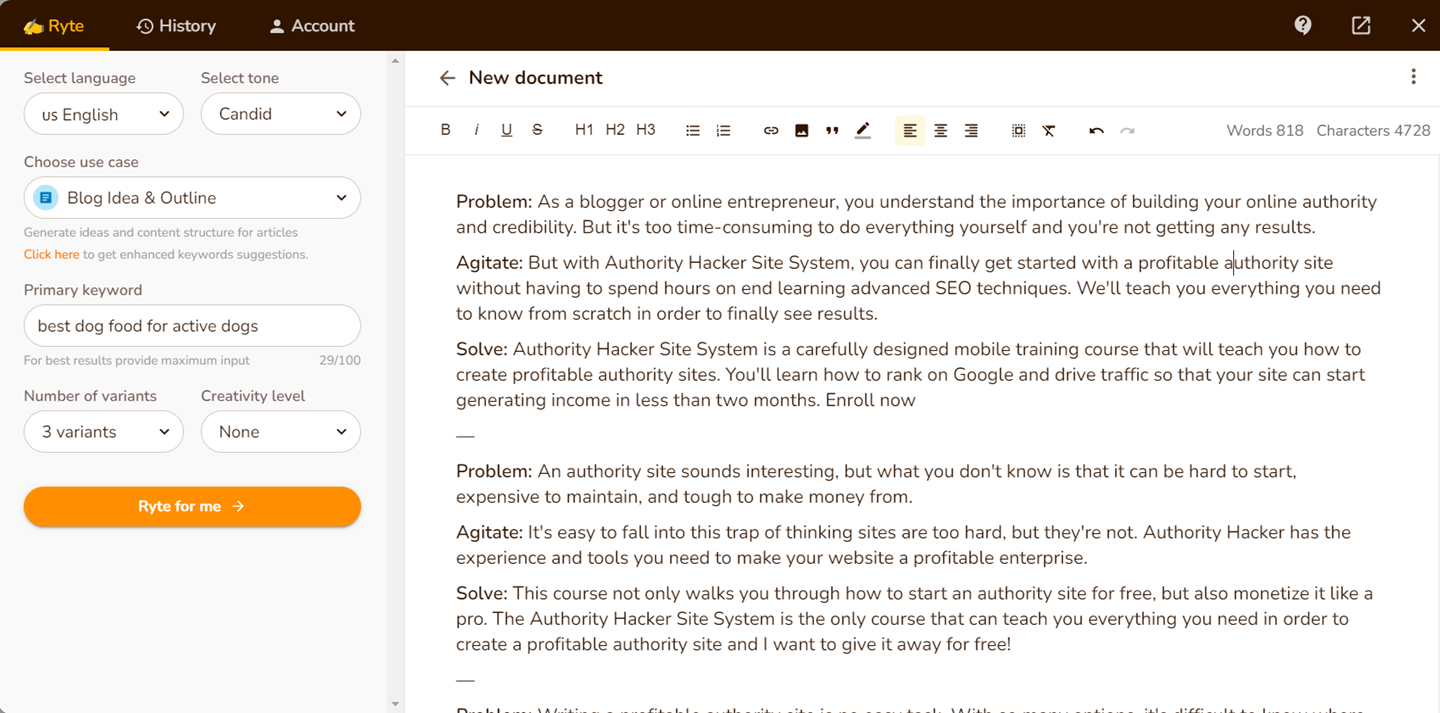
Don’t let this fool you! The tool is compact, but it’s really powerful.
So let’s go through some of its biggest features and use cases, to see how good of an AI copywriting tool Rytr is.
Multi-Language Support
Multi-language support isn’t usually the first feature we mention about an AI copywriting tool.
But things are different in our Rytr review.
And that’s because it has the highest number of supported languages – 29. And it’s especially nice to see that Rytr has support for Hindi, something Jasper or Copy AI don’t.
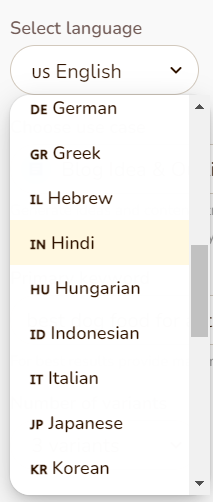
If you need high-quality content in Hindi, Rytr is the best AI writing assistant. Well, it’s the only choice you have.
I don’t speak Hindi, but I’ve tested the tool to see how it works in Spanish and Romanian.
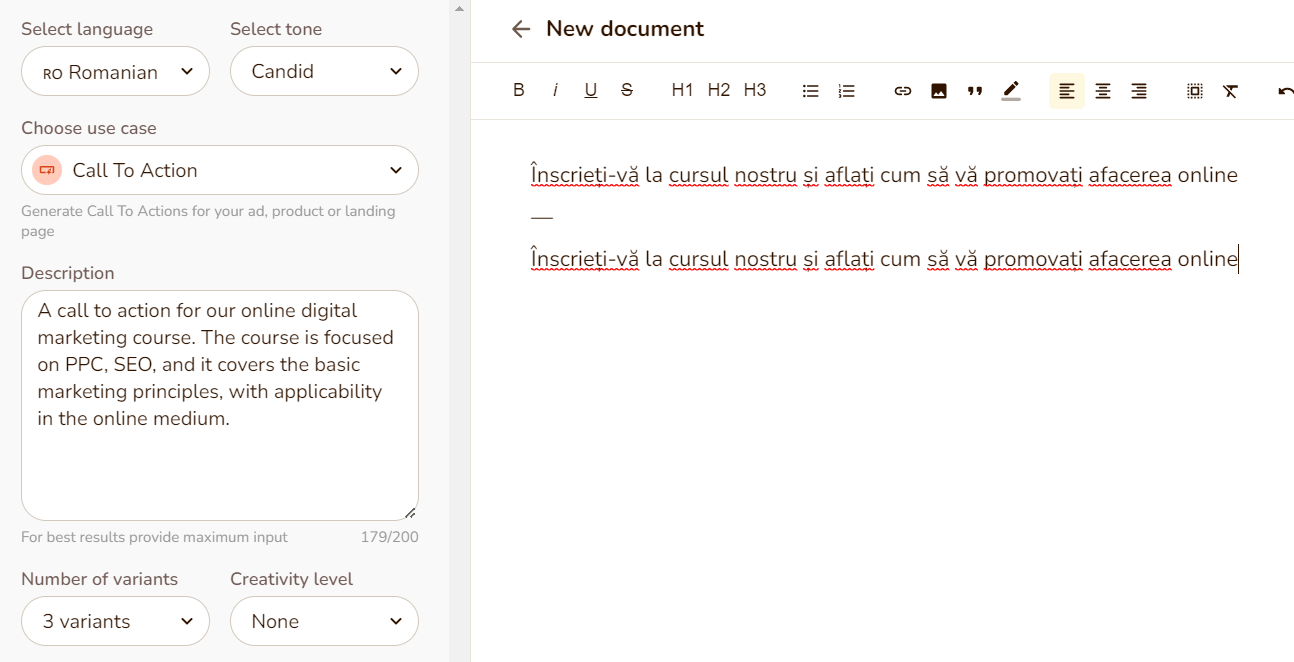
The initial output is good! But it just repeated the same CTA, instead of writing three variants.
The rest of the review will be focused on English content, but Rytr seems to be just as effective (and sometimes buggy) with all languages it supports.
Advanced text editing options
After Rytr creates high-quality content, you can edit the output on the right side of the screen.
The options you get are very helpful.
Here’s a quick summary of everything you can do with your text in Rytr:
Improve. This will correct basic grammar mistakes.
Rephrase. If you like the information in a snippet, but not the way it’s laid out, this option will rephrase it.
Write a paragraph. This will create content based on the text you selected.
Expand. This will elaborate on a snippet of content you like.
Shorten. Pretty intuitive, the opposite of Expand. Great if you need to summarize a blog idea, or any generated content really.
Append. Useful for academic writing.
Check for plagiarism. If you don’t trust Rytr’s output, you can check it for plagiarism at any point.

All of these options let you quickly turn a basic first draft of Rytr’s output into something closer to publish-ready.
Not to mention, the Paragraph tool is the only tool you get to write long-form content.
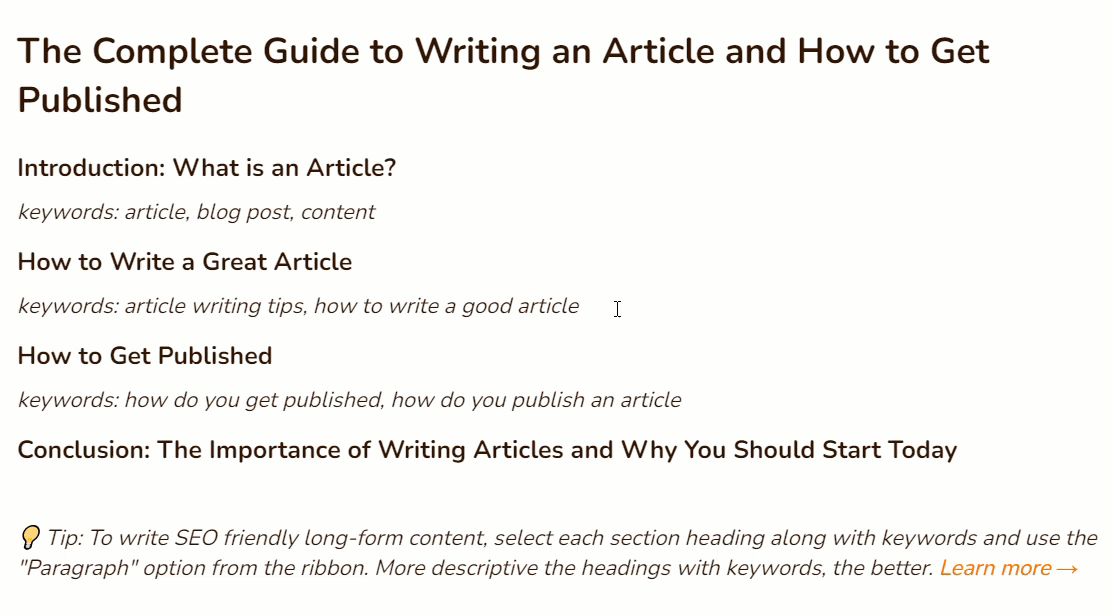
Since all of these options are in the document editor, it really helps you edit generated content really fast.
And trust me, you’ll have to do a lot of editing. That’s just how AI based writing tools roll.
To figure out just how much editing you’ll have to do, let’s analyze Rytr use cases.
Use Cases
If you’re not one for templates, Rytr lets you create your own custom use case. It’s a simple process, but it takes some work to get it right.

With a custom use case, you’ll create your own template with an input field, and example output. It’s a great way to train the AI with existing content, and create a new easy-to-use tool inside Rytr.

If you want to go for it, check out this guide beforehand. Oh, and remember that you need to be a premium user to access this tool.
The simpler, and faster way to create content with Rytr is to use one of the existing use cases.
These are templates that will help you create social media ads, long-form articles, meta descriptions, and plenty of other types of content.
Let’s analyze some of them, to see how effective they are.
Different Marketing Structures (AIDA, PAS)
Rytr can create quality content based on established marketing copy templates like AIDA (Attract, Interest, Desire, Action) or PAS (Problem, Agitate, Solution).
These structures are proven to help you convert more with your copy.
And Rytr can create high quality content with these templates.

But while content quality is decent, as you can see it just repeated the first variant when I asked for more copy. This happens a lot in Rytr, especially with short form content.
Just an annoying technical issue to keep in mind.
Blog Outline and Sections
Before we analyze Rytr’s blog use cases, I want to make something really clear:
Google doesn’t like it when you use an AI writer to create blog posts.
In fact, Google said they will penalize your site if it uses AI content. If and how they check for that, though, is still unclear.
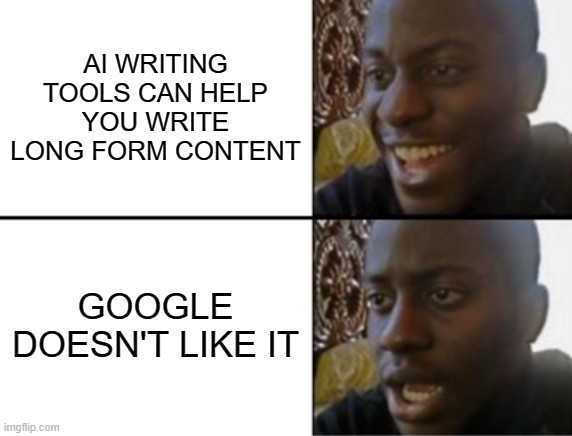
So our recommendation is to write blog posts the old fashioned way.
If you still want some help to come up with ideas, or if you want to risk creating long form content with the help of AI, Rytr has two templates you can use.
The blog outline template will help you structure your article:

And the sections template will help you write out individual sections in your blog posts.
As you might guess, it’s not the ideal set-up to write articles. By contrast, both Jasper and Copy AI offer much better options for long form articles.
So if you’re going to risk Google’s wrath, Rytr is not the best option to write articles.
Call To Action
Calls to action are crucial if you want a better conversion rate.
On your sales landing pages, blog posts, or emails. It doesn’t matter where you put it.
A good CTA can work wonders for your bottom line.
Unfortunately, Rytr’s CTA use case is not too helpful:
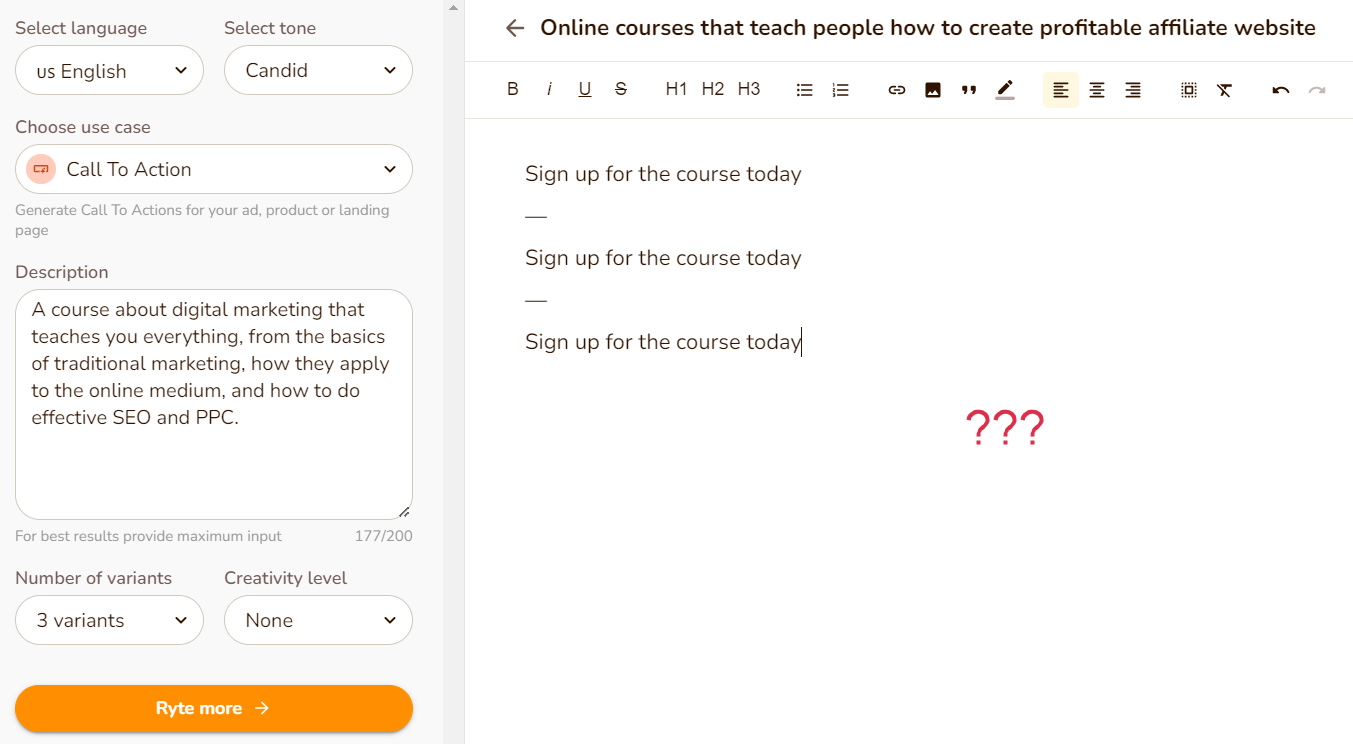
It repeated itself, and it didn’t really care about my input. It just came up with a basic, general call to action.
Post And Caption Ideas
Rytr’s post and caption ideas use cases help you generate social media content.
They’re somewhat helpful?
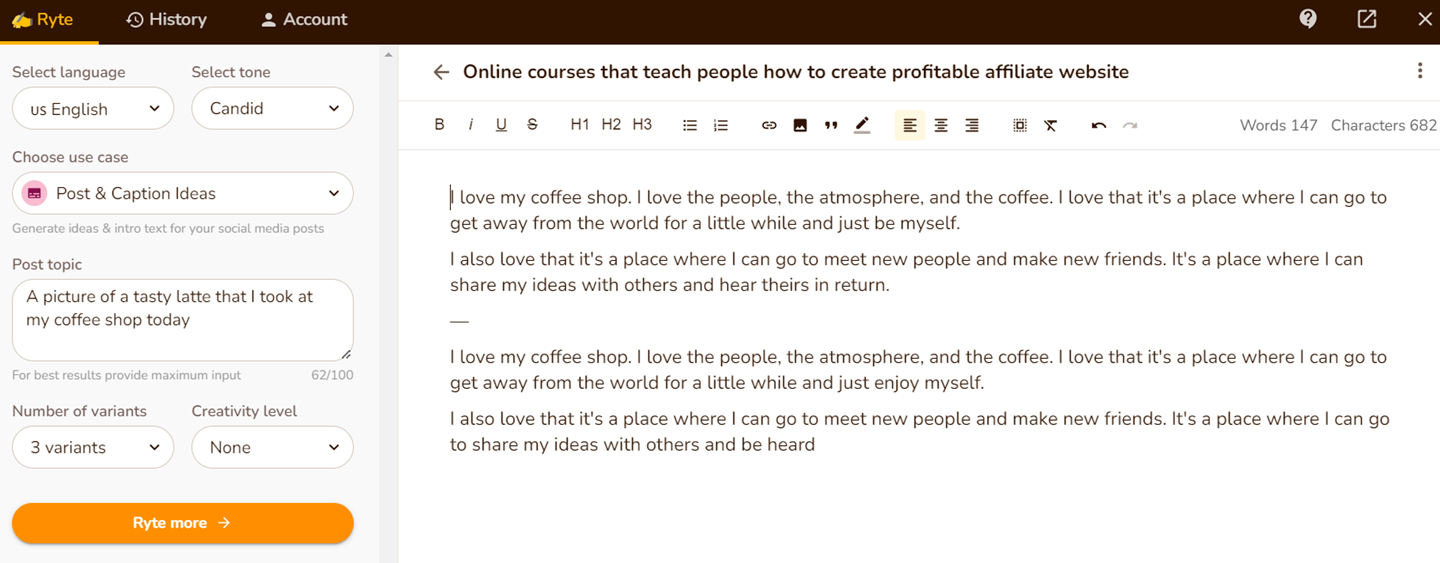
But they’re repetitive (again) and drawn out.
By comparison, Jasper is much better at creating post captions.
Its social media templates are far more numerous, and the output is much better. In some cases, it was actually publish-ready.
If you’re on the look out for help with social media content creation, read our Jasper review.
Video Description and Idea
Coming up with video ideas can be complicated. But I think AI writing tools aren’t the solution for that.
If you want to find success on video-first platforms, you need to think outside the box and find your own formula.
AI tools can’t give you that.
That being said, Rytr’s video ideas are good:

And the video description might help in some cases:
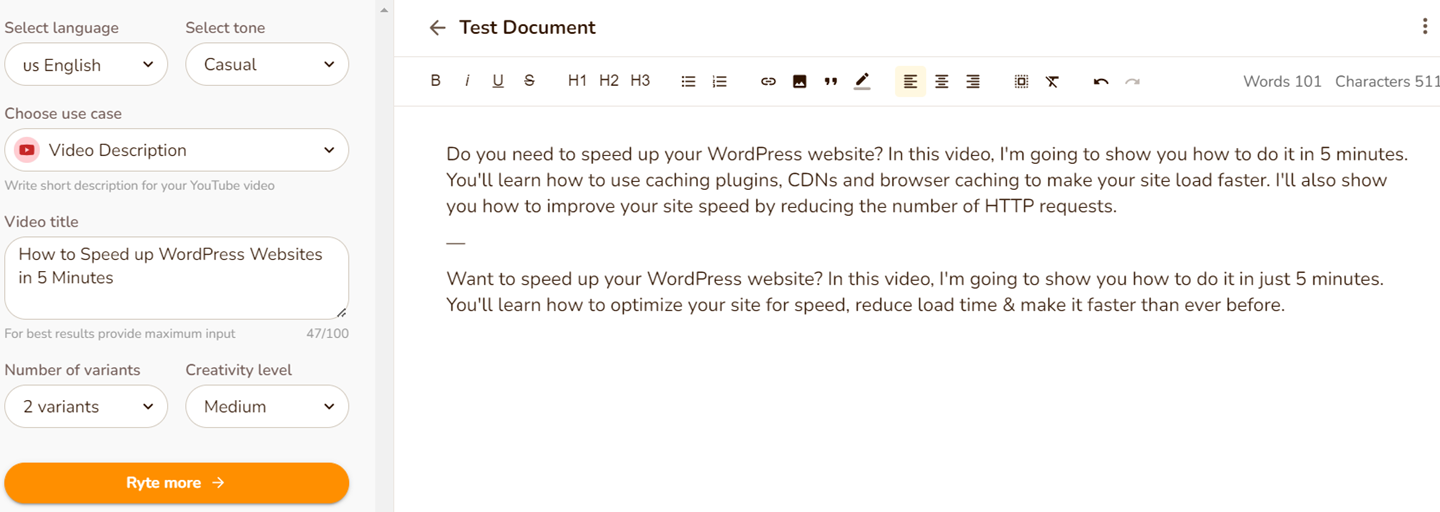
If you’ve ever read a YouTube video description, you know that a description like that is not enough.
It should be longer, and filled with CTAs and references. But it’s still a starting point.
Rytr has plenty of other use cases, which you can discover if you sign-up for an account. But these are the most important ones.
All in all, some surprised us with decent content writing.
But on average, the content quality of Rytr output is not impressive.
Integrations: Rytr’s Saving Grace. Not!
Rytr can integrate with SEMRush, which helps you get keyword ideas to use in your articles.
Other than that, you can’t spice up your Rytr experience.
But you can integrate Rytr into other systems with their API.
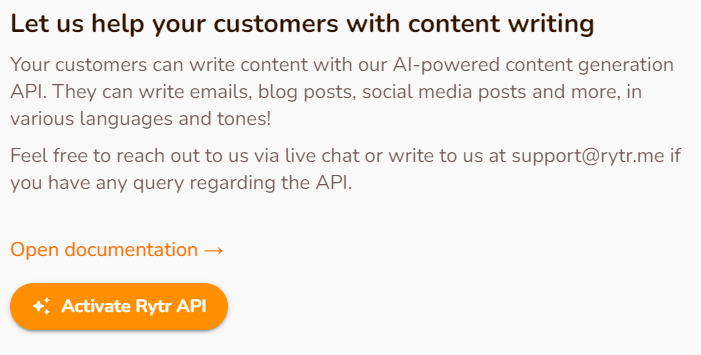
As far as we know, no other AI writing tools offer this option, so if you need to use AI content creation as part of your business processes, Rytr is the only one that can do it.
But Rytr’s competitors have much better integrations. Jasper, for example, has an add-on for Grammarly, a seamless plagiarism checker, and an SEO mode which opens Surfer in your Jasper document.
A Compact Design
We don’t usually focus on design in AI writing tools review.
At least not too much.
But in this case, I think Rytr’s sleek design and compact interface really make the tool stand out among its competition.

The reasons why are evident when you have a lot of content to generate.
So let’s do a small exercise.
Imagine you need help writing a video script, and then an email and a social media post promoting it.
Rytr might struggle with the first part – it has no use case to generate video scripts.
But we created our own use case for a video script outline:
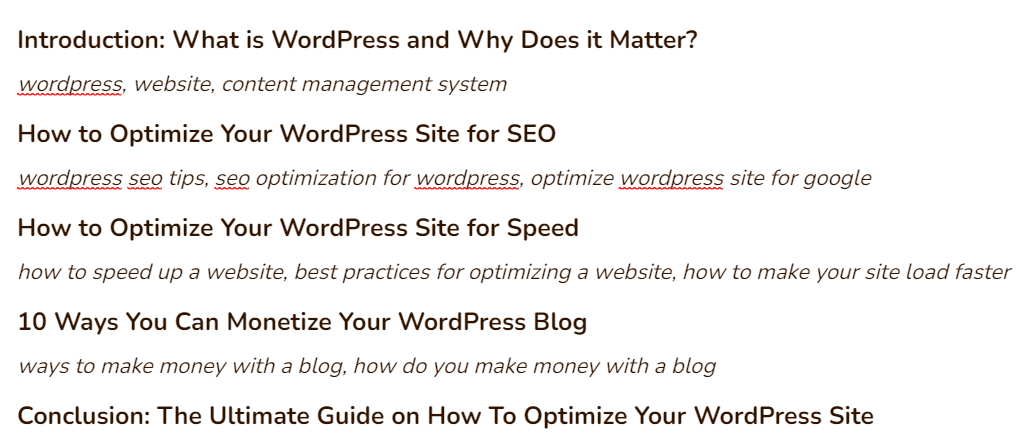
The first part of this demonstration doesn’t matter too much though.
The good stuff comes after you have your first piece of content.
In Rytr, you can just select another use case from the drop-down menu and get on with the email:
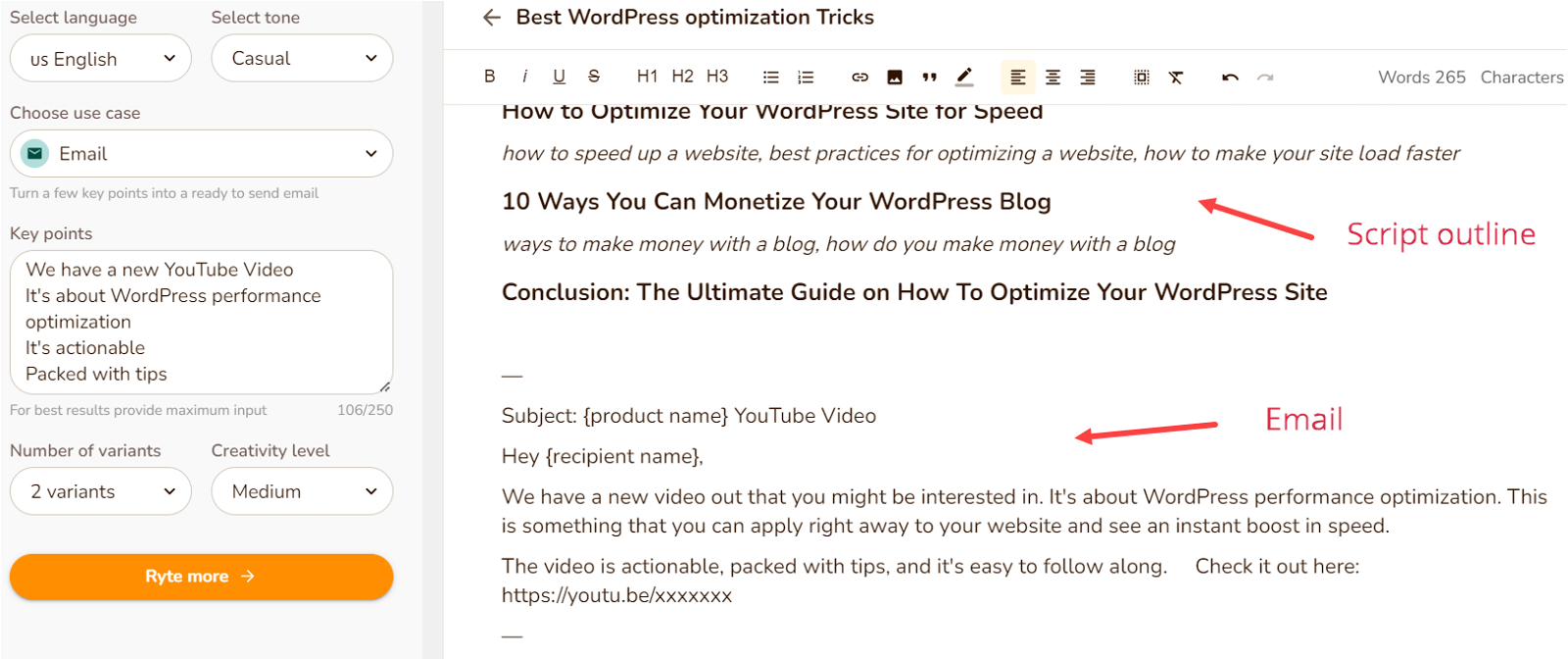
And then pick yet another one to create the social post:

All the features you need are in the same place.
In all other AI tools, you’d need to open new documents for each template.
It might not sound like a huge benefit at first, but it can really help you streamline content creation.
Is it enough to make up for the lacking templates though? That depends on what templates you need. If you only need social media content, the compact design is not enough to forgo Jasper and invest in Rytr.
If you need help with more types of content, including marketing copy and video descriptions, Rytr might be worth it.
Rytr Pricing: Flexible and Affordable
Rytr has three plans you can choose from:

The free plan may look like a great AI writer on a budget, but it’s not. You get a very small limit on the characters you can generate, which comes down to about 800-1000 words.
So really, the free plan is just a trial.
The starter plan isn’t perfect either. For $9/month you only get around 10.000 words. Much better, of course. But still not enough if you want to justify using an AI writing tool.
You need to understand, this thing takes some time to master.
If you want to create your own custom use cases, generate creative content, and really take it for a ride, you’ll need to pump out a lot of content.
So the most expensive plan is really the only viable option if you want to invest in Rytr. Simply because it lets you generate unlimited characters.
Not to mention, it’s extremely affordable, at only $29/month. Much less than what you’ll spend on Rytr’s competition.
Rytr Support
If you ever need help making the most out of Rytr, you can contact their support team.
There’s a chat heads available in the bottom-right corner of Rytr’s interface:
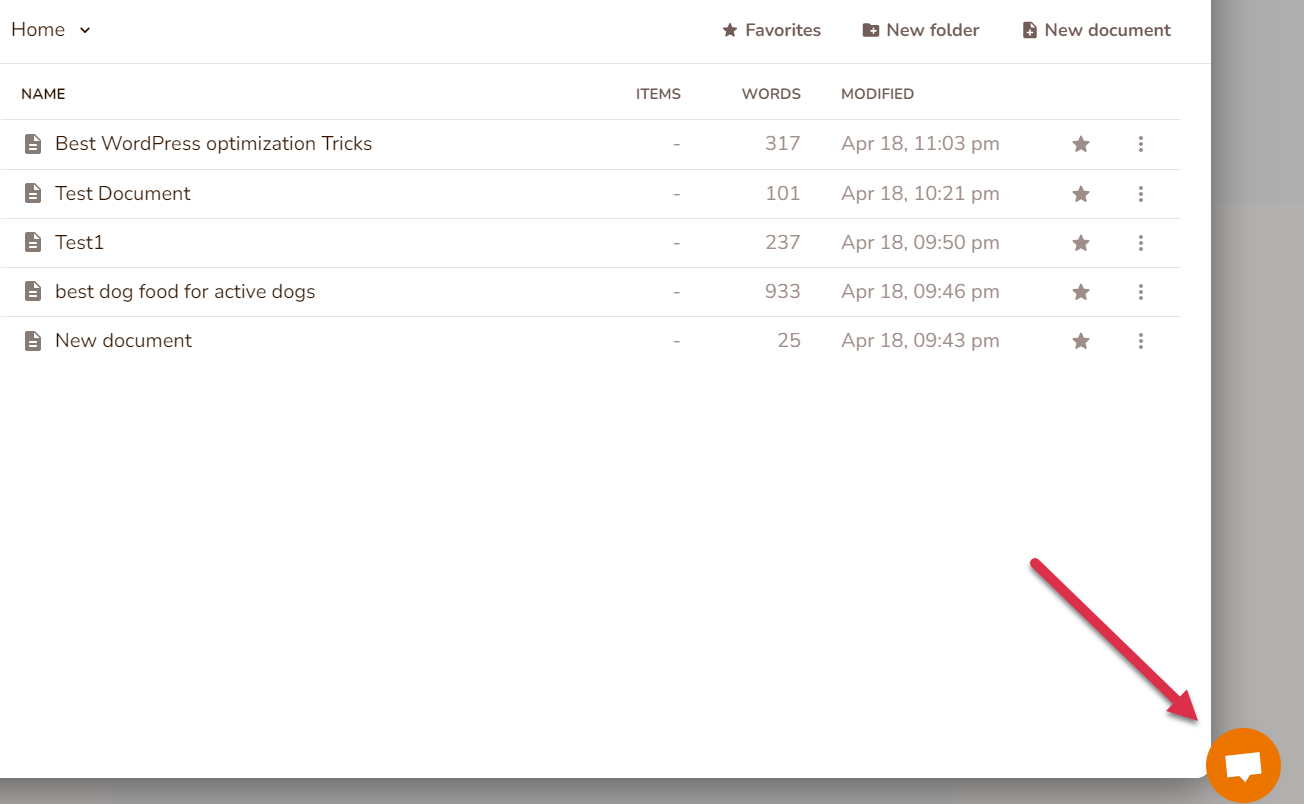
However, they don’t offer chat support.
Instead, you’ll get a reply to your chat message in a few hours. So really, this is just a fancy ticketing system.
If you don’t need assistance from another human, you can also access Rytr’s pretty decent knowledge base:
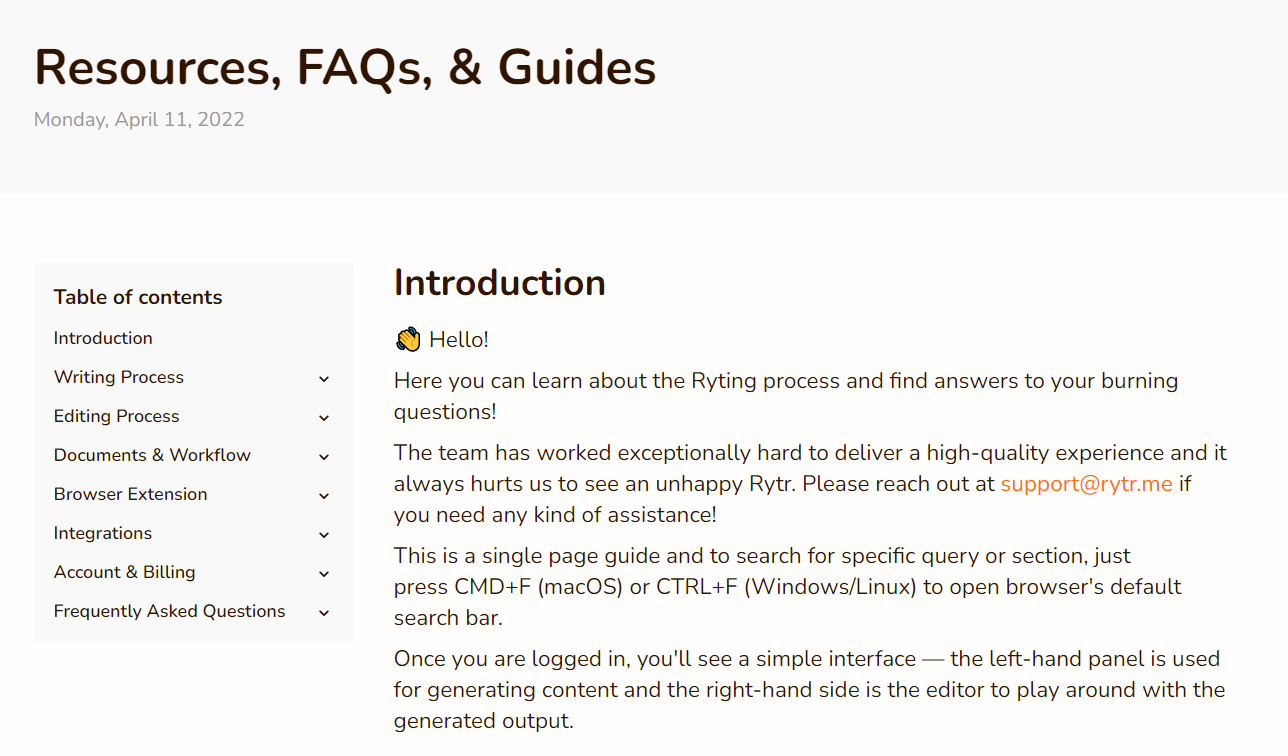
The only downside to this knowledge base is that it’s not easily accessible. You need to do some digging for it.
Test Performance: How Good of a Writing Assistant is Rytr?
You’ve seen everything Rytr can and can’t do.
So now let’s hone in on its core functionality – how good is it at producing content?
For this performance test, we usually have AI writing assistants write an entire blog post on the keyword “best dog food for active dogs”.
In this case, however, Rytr doesn’t have a tool for writing blog posts from A to Z.
So we’ll need to help Rytr create a blog post step by step.
Here’s how we did it:
First, we created an article structure with the Blog Idea & Outline tool. Here’s how it looks:
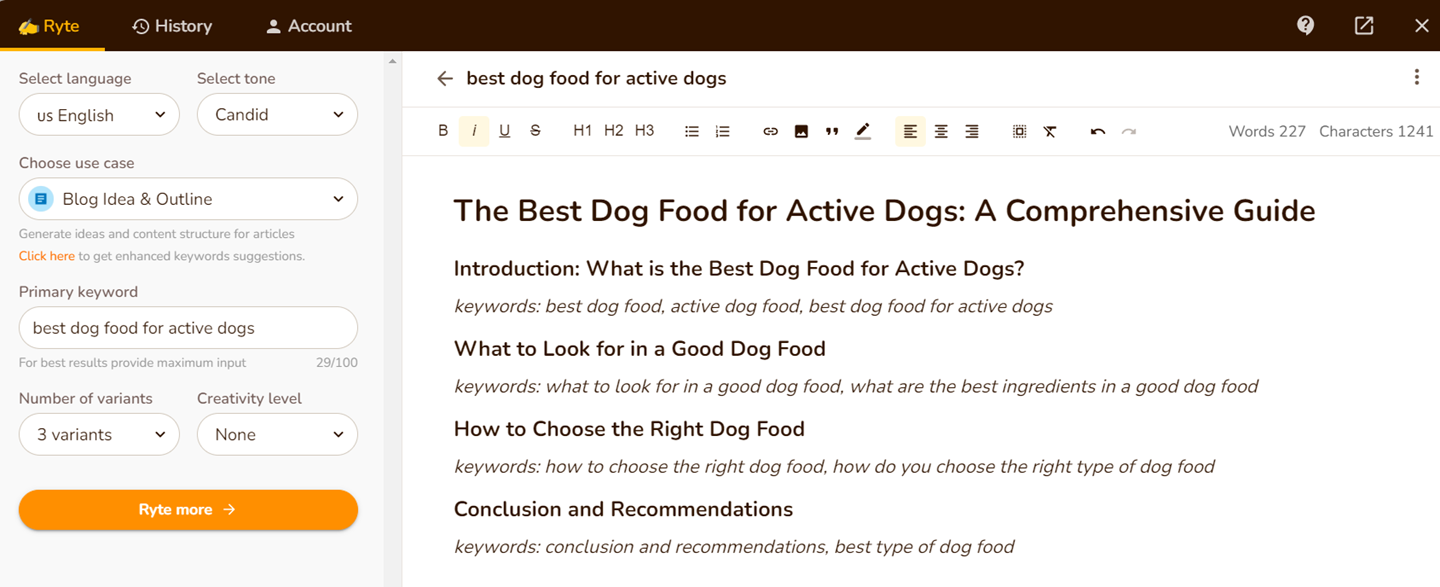
It’s not the best. Like most AI writing tools, Rytr can get pretty repetitive. So we did some course corrections to the outline:

We added some headings that directly reference dog food products fit for the article, as well as some mentions on what to include in the main heading before the products.
Then, to make Rytr actually produce the content we want, we used the paragraph tool. Just select a snippet of the text, and click on “Paragraph”:
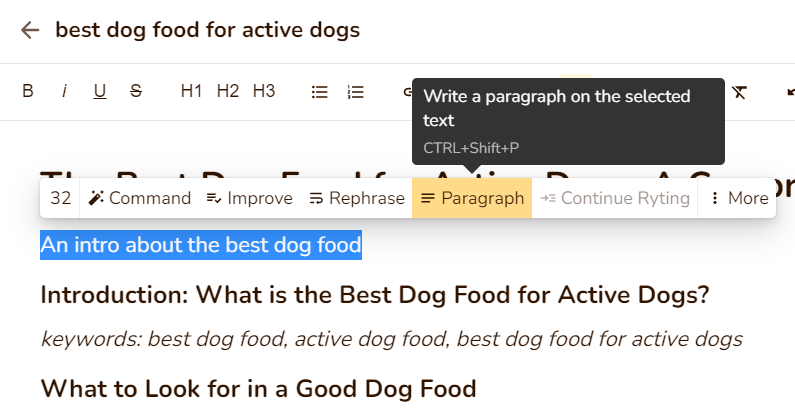
Here’s the output for the intro:

We don’t know who Bonzo is, but other than that it’s a pretty decent output considering our vague command.
Then, we did the same thing for all paragraphs. Here’s what we came up with:
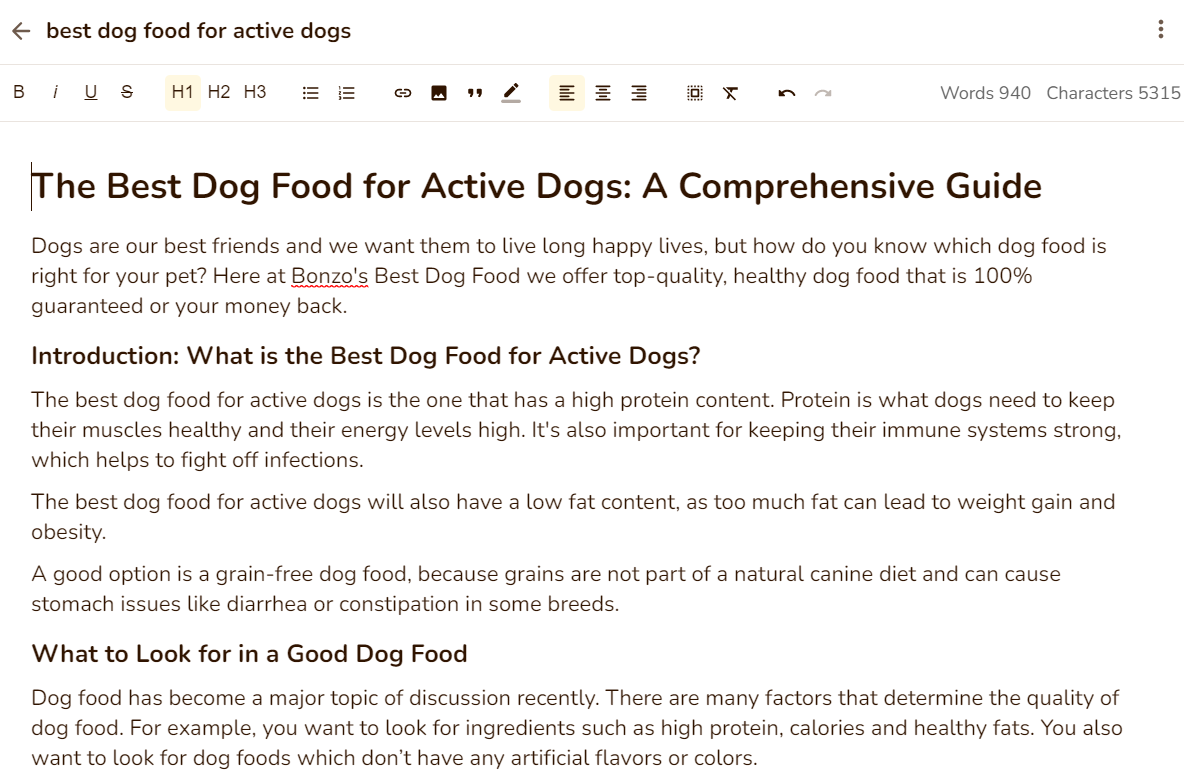
If you want to read the whole blog post, you can download it here.
Unfortunately, like its competitors, Rytr struggles with factual information. It makes stuff up, so you’ll need to fact check EVERYTHING.
Overall, Rytr had a below average performance in our test.
And it missed the mark really badly on some stuff:

Not to mention, the content in the article itself is repetitive. You might get better results with more information on each section, but as it stands now it’s far from publish-ready.
Oh and – all of this is while we edited the outline to fit our needs quite heavily. By comparison, other AI writing assistants like Jasper and Copy AI managed to come up with WAY better outlines for the same keyword.
How To Use Rytr The Ryt Way
Yes, the pun is intentional.
No, I will not apologize. Take it up to Rytr if you’ve got a problem with it, they’ve been influencing me with their own bad puns.
But enough with the sidetrack.
I think Rytr is a smart investment if you can use it to its full extent
So how can you make the most out of Rytr?
As is the case with most AI writing tools, you can’t pump out quality content with just a few seconds invested for the input.
GPT-3 only indexed 10% of the internet when it was launched a few years ago. And it hasn’t been updated since.
This means that, for example, GPT-3 has no clue what CoVid is.

So if you want Rytr to create high-quality content, you’ll need to help it.
And the best way to do that is to experiment with the document options, especially the paragraph one.
On top of that, here’s what you can do to make the most out of Rytr:
Get the $29/month plan. You need unlimited words to make this work.
Structure your input very clearly all the time. It will help the AI understand what you need better.
Use three variants. There’s a reason this is the default in all other AI writing tools.
Edit the output all the time. No matter how good a use case or tool can get, you’ll always need to edit Rytr output. Pretty heavily sometimes.
Who Is Rytr For
You’ve seen what AI copywriting tools can do in our Rytr review.
So should everyone invest in one?
Who is Rytr best suited for?
Rytr is the cheapest AI writing tool. So if you need one and you have a tight budget, Rytr is the best choice. Not to mention, Rytr is the only choice you have if you want content in Hindi.
Beyond that, I think you can make the most out of Rytr if you need help creating a lot of short-form content – think emails, social media posts, or even video descriptions.
Copy AI is best suited for overcoming writer’s block in a variety of content categories.
And Jasper AI is the all-around king of AI copywriting tools.
Conclusion: Should You Invest in Rytr
A lot of our visitors have affiliate sites and need help pumping out a lot of blog articles.
For anyone else though, Rytr can help in the editorial process. Especially for short-form content. So feel free to give it a try:
Rytr Review 2024: Affordable, But Is It Good Enough?

If you want an AI writing tool that won’t bankrupt you, Rytr might be it. Read our Rytr review to find out more.
Price: 9
Price Currency: $
Application Category: AI Writing Assistant
4.5






